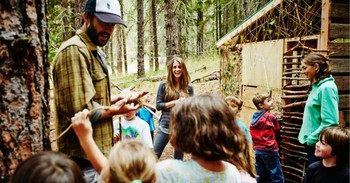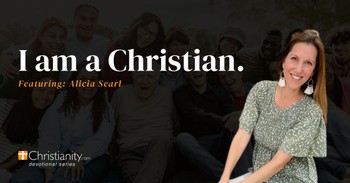The catechism is a foreign concept to many evangelical Christians. It may evoke a sense of mystical reverence or a yawn of boredom. It may connote religious emptiness. But much is to be learned from this ancient practice of systematically teaching the truth about God through questions and answers. Indeed, many Christians are learning new ways to use this method (see the resources listed at the article’s end.)
My 9-year-old son John put it this way: “Sometimes I think about the questions and answers [of the catechism] when I’m lying in bed waiting to sleep. The question I think about the most is, ‘what is God?’ It’s hard to understand because people can’t make pictures of him.”
What Is the Catechism?
Catechism is a method of teaching something in a systematic way. The question–answer format has been used historically and widely.
When people say the Catechism, they may be referring to the standard list of questions and answers used by the Catholic church. This list has been modified over the years, but Catholics are currently working off of a document published in 1992, which is adapted by church leaders for their unique settings.
Why is there a special word for it? “Catechism” comes from a Greek word, Katecheo, which simply means “to teach.” Some churches demonstrate their value for connecting with our ancient roots by using the same terminology used for millennia.
Is it just for Catholics? No. Lutherans, Anglicans, Presbyterians and many other groups use a catechism. Martin Luther developed the Small Catechism, still used by Lutherans today, after going on a tour of the parishes under his care and realizing how desperately they needed easy-to-understand instruction on Biblical truth.
In 1529 Luther said, “How pitiable, so help me God, were the things I saw: the common man, especially in the villages, knows practically nothing of Christian doctrine, and many of the pastors are almost entirely incompetent and unable to teach. Yet all the people are supposed to be Christians, have been baptized, and receive the Holy Sacrament even though they do not know the Lord’s Prayer, the Creed, or the Ten Commandments.”
What is the goal of the catechism? The purpose of the catechism is to provide a firm foundation for our faith, based in scripture. It systematically builds an understanding of what we believe, removing it from the realm of fairy tales and defending against distortions of truth.
Where Did the Catechism Come From?
The first generations of the Church (A.D. 50-500) focused on educating people using
As the Church began to grow, pastors needed a way to know whether someone was ready to be baptized. They began to establish a curriculum based on these three texts to teach new believers and children.
When did the church start using a question-and-answer format?
The Q&A format seems to have become more established during the Reformation (1517-1648). Leaders like Martin Luther sought to make Biblical truth accessible to everyone, which meant equipping pastors and lay leaders with easy-to-use tools. The development of the printing press was a big help in this!
Another element of the Reformation was defining what each church group believed. Luther and others wanted to get back to the values and teachings of the Early Church, so they focused their catechism curriculum on the three texts linked above.
The Roman Catholic Church also created a catechism to clarify its uniqueness from the Protestant church as part of the Counter-Reformation. Their first official catechism was commissioned at the Council of Trent in the mid-1550s.
What defines catechism in contrast with other types of curriculum or teaching?
There is a huge array of Bible teaching available today. “Curriculum” could refer to a Bible study on a particular book of the Bible or on a topic helpful for believers.
Catechism emphasizes the systematic teaching of Bible truth based on foundational information that every believer should know. It’s a covering of the bases before moving on to other material. Many churches teach the catechism before baptizing or confirming church members.
Also, the question-and-answer format is designed to be easy for leaders to adapt to their own situation. This is helpful given that many curricula require learners to watch a video or read a book before a discussion will be meaningful. A catechism can be taught with no prior knowledge on the part of the learner and little training on the part of the leader.
How Can I Use the Catechism for My Family, Church, or Ministry?
Many parents and leaders use a version of the catechism that’s adapted for their unique context. Some denominations have specific catechisms that can be simplified or modernized, and there are many resources online for those trying to figure this out on their own.
What are the pros and cons of using a question–answer catechism at home?
Pros: Parents don’t have to reinvent the wheel or have all the answers on their own. Kids are wired to ask lots of questions, and they expect grown-ups to know the answers. Using a catechism equips them with answers to some of the most important questions they’ll ask. And it encourages more questions and discussions about spiritual life.
Cons: The question-and-answer format is great for elementary kids and older but hard for kindergarten and younger. For these ages, storytelling, songs, and simple prayers are recommended methods for teaching. For those with middle through high school aged-kids, consider allowing ample time for them to develop and share their own thoughts. They will respect the standard answers more if they feel that they also have been respected as thinking individuals.
Will kids feel brainwashed if they’re taught to answer by rote?
While there’s no way to guarantee how our kids will respond, it does help to remember that children pick up on unspoken cues. They will store away information about your attitude, and that of their church leaders, along with the answers they’re memorizing. Carefully consider your own intentions. Do you want to prepare your children to recite their answers properly in some performance-type setting, or do you want to develop their understanding of God?
Consider the following scenarios, both real experiences by the author:
Scenario 1: Two pre-teen girls sit in the church lobby during the sermon, practicing for an upcoming Bible Quiz event. One girl would read the start of a question and the other girl would zip through a memorized answer before the first girl could finish asking the question.
Scenario 2: At a family dinner table, after the initial round of “pass the butter,” a father refers to a list of questions. He reads the next question on the list, giving a chance for some of the kids to answer with their own ideas. Then he reads the answer from the page and has the kids each repeat it. They discuss its meaning (each kid understanding it at a different level) and review it regularly.
No system of teaching is guaranteed to keep people from simply going through the motions, but our attitude as leaders will set the tone for those who are learning from us.
One perspective to consider is that a catechism teaches what the Christian faith is founded upon. By teaching the answers to these questions, you are not mandating that your learners believe these things. You are giving them a solid base of information so they can make their own decisions.
How can the catechism be adapted for group?
The systematic nature of a catechism makes it a helpful tool for those seeking to train Christians in their faith. Leaders must first identify what truths they want every believer to know and then develop a list of questions and answers geared toward their unique needs.
Resources
(This is not intended to be a full endorsement. Please review these resources with your own discernment!)
The New City Catechism, (developed by Tim Keller and others) is designed to help children ages 8–11 learn the core doctrines of the Christian faith in a Sunday school, classroom, or homeschool setting.
Tips on using a catechism in a home setting, with some resource suggestions of her own: https://www.intoxicatedonlife.com/teaching-catechism/
Catechism resources geared toward youth and college students: https://feed.bible/catechism
A simple list of catechism questions, “for boys and girls.” http://www.reformedreader.org/ccc/acbg.htm
(Author’s note: I am grateful to my husband, Josh Boman [MA in Theological Studies] for his insights on this topic. He is passionate about applying the wisdom and fervor of the Early Church to present-day spirituality.)
Photo credit: Unsplash/Aaron Burden
This article is part of our Christian Terms catalog, exploring words and phrases of Christian theology and history. Here are some of our most popular articles covering Christian terms to help your journey of knowledge and faith:
The Full Armor of God
The Meaning of "Selah"
What Is Grace? Bible Definition and Christian Quotes
What is Discernment? Bible Meaning and Importance
What Is Prophecy? Bible Meaning and Examples








